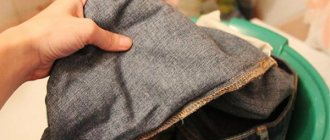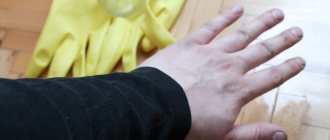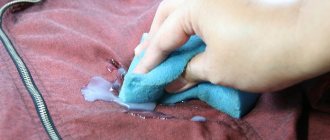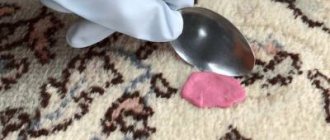Resin that gets on clothes is considered a difficult-to-remove contaminant. This adhesive substance is able to penetrate deeply into the fibers of the fabric and glue them together.
There are two types of resin: plant origin and artificial.
The plant is a sticky, hardening sap that is secreted by trees such as spruce, pine, linden, and poplar.
Artificial is obtained through chemical reactions and is used in construction, repair work, and for making jewelry. In its normal state, the resin is solid, but when heated it becomes liquid.
Wood resin is much easier to remove from fabric than synthetic resin.
What not to do?
A large number of clothes are spoiled due to ignorance of the principles of working with the material. Let's consider the main points that need to be taken into account in order to remove hardened marks from clothing:
- The most common mistake is rush washing. Many housewives immediately try to soak and clean the soiled item. If you wash it ahead of time, the substance will become even denser, will become embedded in the fabric, and will be difficult to remove. Therefore, you should treat it before washing your clothes.
- Do not rub the stain if pine resin gets into it. As a result of heating, it will eat into the fibers and become larger.
- Do not use alcohol on delicate items. Use oil and dish gel as a cleaning agent.
- Do not use bleaches on colored fabrics.
- Do not violate the time intervals during cleaning.
- Do not use gasoline or other solvents on synthetics.
- Do not soak the product with other dirty items.
Super glue
Moment glue stains, like other types of super glue, are the most difficult to remove without damaging the material. They eat heavily into the fabric.
It comes in two varieties: in gel form or universal. The first option is removed with nail polish remover without acetone. On leather clothing, it can be carefully removed with a nail file.
You can try removing other types of super glue with a regular solvent.
Traces of super glue are washed off from silk fabrics in a vinegar solution. Vinegar and water are diluted in a ratio of 1:2.
Stains are removed from denim with acetone, solvent, nefras, or any nail polish or paint remover.
Preparation
To successfully remove resin from clothing, several preparatory steps must be taken:
- Remove dust and dirt from the surface of the product to be cleaned;
- turn a thing inside out;
- carefully rip open and separate the lining, if any;
- treat only the contaminated area of the fabric;
- to prevent the stain from spreading, moisten the area around it and sprinkle with starch;
- place a piece of plywood, wood or plastic under the surface to be treated;
- wear protective gloves.
Aggressive substances should be tested on an inconspicuous area of clothing. If the fiber structure remains unchanged, continue the procedure.
Bitumen stains
Bitumen or tar is used in road construction and roofing work. Stains from leather items can be easily removed with vegetable oil, but it is more difficult to clean denim trousers or other clothes from such stains.
Natural dense fabrics are cleaned of bitumen with gasoline, acetone or white spirit. The liquid is poured onto the stain, and after a few minutes, when the resinous substances have softened, it will be possible to wipe off the dirt with a cotton swab.
But things made from synthetics are more difficult to save. A good result cannot be guaranteed, since those substances that dissolve bitumen can also dissolve fabric fibers.
You can try to remove the stain with the same substances that are used for natural fabrics. But you should be prepared for the fact that the product can be damaged; an irremovable light stain or hole will appear on the fabric.
Mechanical method
The first step to purify resin is mechanical processing. It is necessary to carefully remove the frozen crust with a sharp object. You can take a knife, wooden spatulas, a razor blade, a spoon. Do not stretch the fabric; only clean the top layer of the product.
Attention! Silk and thin knitwear are easily damaged, so the mechanical method is undesirable.
Impact of temperatures
Heat treatment of the material allows you to remove fresh contaminants. This can be a heating operation or, conversely, cooling.
When exposed to low temperatures:
- Place spoiled clothing in the freezer for 1-2 hours. During this time, the resin will harden and become brittle.
- Wrinkle clothes. Only small pieces will remain that can be removed with a brush. There is no need to crush thin material; just rub and shake off any remaining hardened resin.
Advice! If the product does not fit in the freezer, you can attach pieces of ice to it. The effect will be the same.
High temperatures are used to remove resin from delicate fabrics.
To clean using heat, follow this procedure:
- Place cloth napkins on both sides.
- Iron with a hot iron.
- The crust will begin to melt and absorb into the fabric. When the napkin becomes dirty, remove it and replace it with a new one.
- After cleaning, rub the damaged area with laundry soap. Wait 15-20 minutes, wash.
Advice! If the material is very dense, use a hair dryer. Mentally divide the trace into several parts (about 5 cm). Blow hot air over the areas one at a time and remove dirt. Remove the remains with a napkin.
Solvents can be used if a trace remains after using heat treatment.
How to clean fresh?
Most of the resin that gets on clothes has a viscous, thick consistency. In this form, you can try to remove it with a napkin. After removing the top layer, a mark will remain on the fabric, which will have to be removed separately.
You can try to remove the resinous composition that hardens in a voluminous drop and dries out mechanically using a knife, spoon or other object. Such actions must be carried out very carefully to avoid tissue damage.
To remove and dissolve the remnants of such a substance, you will need to use drugs that are active against organic resins. They are even easier to remove than synthetic compounds, such as epoxy.
Chemicals
There are always effective chemicals around the house that will help remove tar from clothes. When working with them, it is important to follow several rules:
- Wipe off marks carefully, avoid contact with skin: chemical solutions can cause burns.
- It is better to apply solvent or stain remover to minor stains using a pipette.
Attention! Treat with flammable liquids away from open flames.
How to remove from skin?
Soda with salt
If you were removing resin from your clothing and it accidentally stuck to your hands, don’t panic.
This substance is not harmful to the skin, but it still needs to be removed. How to wash resin from hands:
- baby cream;
- soda;
- baby oil;
- gasoline or acetone;
- vegetable oil;
- citric acid;
- ice.
Don't even try to remove resin with water. This method will only help it harden and grip better.
A walk in a pine forest can be overshadowed by an unpleasant surprise. The clothes will be damaged by the resin, but you shouldn’t throw them away right away. After all, you can remove it at home using folk remedies.
A tar stain is difficult to remove due to its physical characteristics, but it is still possible. As a last resort, take the item to the dry cleaner; experienced specialists will take care of it.
Want to know how to remove tar from clothes? The secret is that you don’t even need to wash it! The first step towards clean clothes will be the mechanical removal of contamination.
- The easier it will be to remove stains the more resin you can remove before using solvents. Make your job easier by picking off as much resin as possible with a sharp object or, if you don’t have anything sharp on hand, with your fingernails.
- If you have removed almost all the resin, you can skip this step, but if you still cannot see the structure of the fabric through the resin, you need to reduce the amount even further. To do this, throw the clothes in the freezer for an hour or put something cold on the stain, such as frozen vegetables or meat. After freezing, some more resin can be cleaned by rubbing the stain; the resin should crack and fall off, leaving behind a less intimidating stain.
- Another mechanical method for removing resin can be considered heating the contamination with an iron, so that the resin, having assumed a viscous state, transfers to prepared substrates in the form of a sheet of paper napkins or a strip of cotton fabric. This method is suitable if you have already tried both of the previous methods, but there is still a lot of resin in the fabric structure, and if you do not want to remove the stain with solvents from delicate or dyed fabric. For those who still intend to resort to less gentle methods, this stage is not at all necessary.
Oil + dishwashing liquid
Fresh resin that has not had time to dry is the easiest to clean. The detergent has degreasing properties, so it is used to remove oil stains. You can wash clothes using the following method:
- Treat the damaged area with oil. Wait 30 minutes.
- Pour in dish soap.
- Leave to soak for 30 minutes.
- Wash everything off and rinse the product.
Advice! To remove resin from skin, wool or fur, just wait 5 minutes. Then remove the remains with a napkin.
Alcohol
Alcohol and liquids containing it are good helpers in removing tar. We offer two methods to choose from:
- Pour a small amount of alcohol directly onto the damaged area and leave for 20-30 minutes. Rub with laundry soap and wash according to the requirements of the material. If the contamination is old, first apply oil to the damaged area.
- Pour an alcohol-based solvent onto the problem area and wait 20 minutes. Moisten a cotton pad with the same solution and wipe off the stain.
Attention! Do not use as a cleaner on brightly colored items or delicate fabrics: discoloration will occur.
Coca Cola
Coca-Cola contains phosphoric acid, which will help clean the product in the shortest possible time.
Method 1
Moisten the damaged area generously and wait 2-3 hours. You can soak the item completely. When the resin gets wet, rub the stain with a brush and rinse.
Method 2
This method is more gentle. Wash off the dirt with a cotton swab soaked in Coca-Cola and leave for 20-30 minutes. Rinse and wash.
Instead of cola, you can take Fanta, Sprite. To remove traces of resin from light-colored fabrics, you need to use colorless sparkling water.
Attention! This method is not suitable for cleaning white items. They may lose their whiteness.
Solvents
Using aggressive solvents is effective, but quite risky: clothes can be completely ruined. The methods are as follows:
- Acetone. Wet the napkin and wipe with light movements, moving from the edges to the center. Acetone may not work immediately to dissolve the stain. If the mark does not come off the material, repeat the procedure after a few hours.
- Wood resin can be wiped off with a benzine solution. It is necessary to mix it with baby soap in equal proportions so as not to spoil the clothes. Motor gasoline is not suitable for this purpose; special, purified gasoline is required. Cover the resin crust with the resulting mixture and leave for an hour. Wash thoroughly.
- Another effective way to clean soiled clothes is turpentine. Moisten a cotton swab and wipe the contaminated area, wait half an hour. Turpentine will weaken the hardness of the resin. Moisten another swab with alcohol. Repeat the process until the stain disappears.
Attention! All substances have a pronounced odor. Processing should be carried out in a well-ventilated area.
After using any of these methods, wash the item with conditioner.
Let's start cleaning
After preliminary manipulations, a visible imprint still remains on the fabric, so the item is prepared for further processing. It is cleaned with a dry brush and shaken out. The lining is lifted, freeing the contaminated area. A piece of plywood wrapped in a light cotton napkin is placed under it.
To prevent the resin from spreading during the removal process, the fabric around the stain is moistened and sprinkled with starch or talcum powder.
Having chosen a method for removing the resin, they test the product by applying it to the seam from the wrong side. The material should not fade or deform.
Wipe off resin stains with a cotton pad moistened with a selected cleanser, moving from the periphery of the stain to the center.
Once you have finished scrubbing off the resinous print, wash the product by hand or in a machine, but without other items.
Cleaning paste
Old stains can be easily cleaned with a special paste:
- Take 1 tsp. ammonia and turpentine, add 1 tbsp. l. potato starch.
- Apply a thick, thick layer to the damaged area and leave for several hours.
- When the paste and resin dries, rub it with a brush. The dried mixture will be easy to remove from the material along with the resin.
- The procedure can be repeated several times if the mark does not disappear.
- When finished, wash.
Advice. For old stains, cover the hardened crust with butter or vegetable oil in advance. When the resin softens, clean it off with a knife or the sharp end of scissors, and apply cleaning paste to the remains.
Paste with the addition of white clay is also effective. Mix 1 tsp. clay, potato starch and 1 drop of ammonia. Dilute until mushy. Add a few drops of turpentine, mix and lubricate the stain. When dry, remove with a brush.
Cleaning delicate fabrics
- The resinous imprint left on the fur or wool is wiped with vegetable oil. After 25 minutes, wash off the marks with a soft cloth soaked in dishwashing gel.
- Valuable fur is carefully wiped with medical alcohol.
- For a dark wool sweater, turpentine is suitable.
- It is advisable to clean a light-colored wool product with alcohol in which shavings of white baby soap are dissolved.
- The suede is moistened with medical alcohol and grains of resin are combed out in the direction of the pile with a brush with short metal teeth.
- Velvet fabric, natural silk, velor, acetate fabric are treated with alcohol. Or a composition of alcohol, turpentine, potato starch in a ratio of 1:1:2. Maintain on contamination for 12 hours. Before washing, rinse the product in cold water.
- If the fabric cannot be washed, the resin is moistened with ether and then soaked in medical alcohol. If necessary, repeat the procedure.











